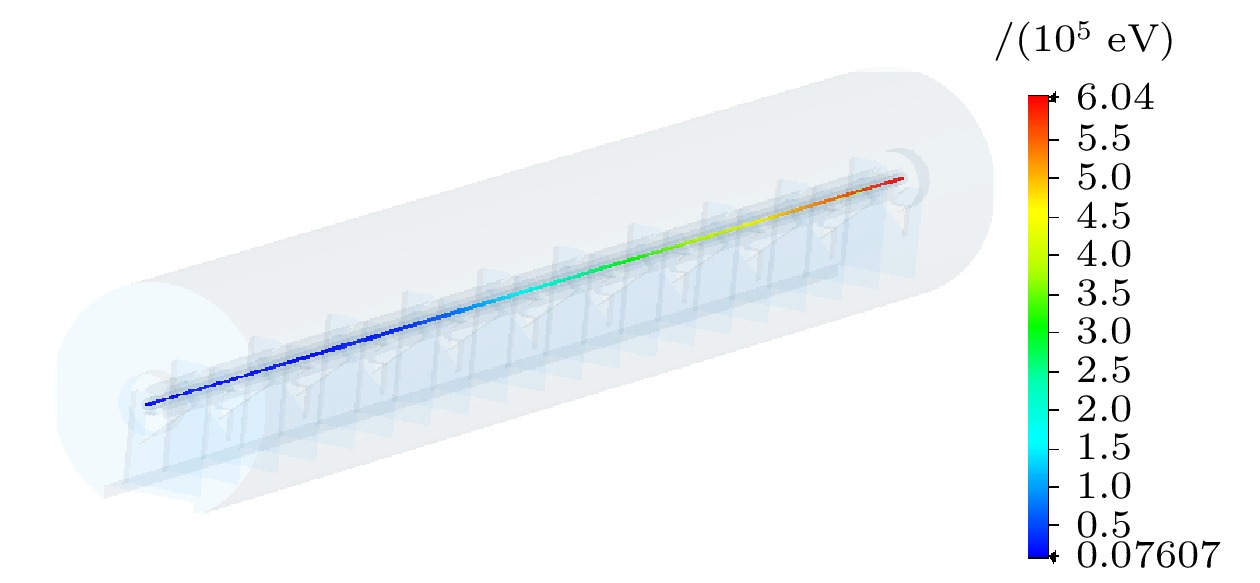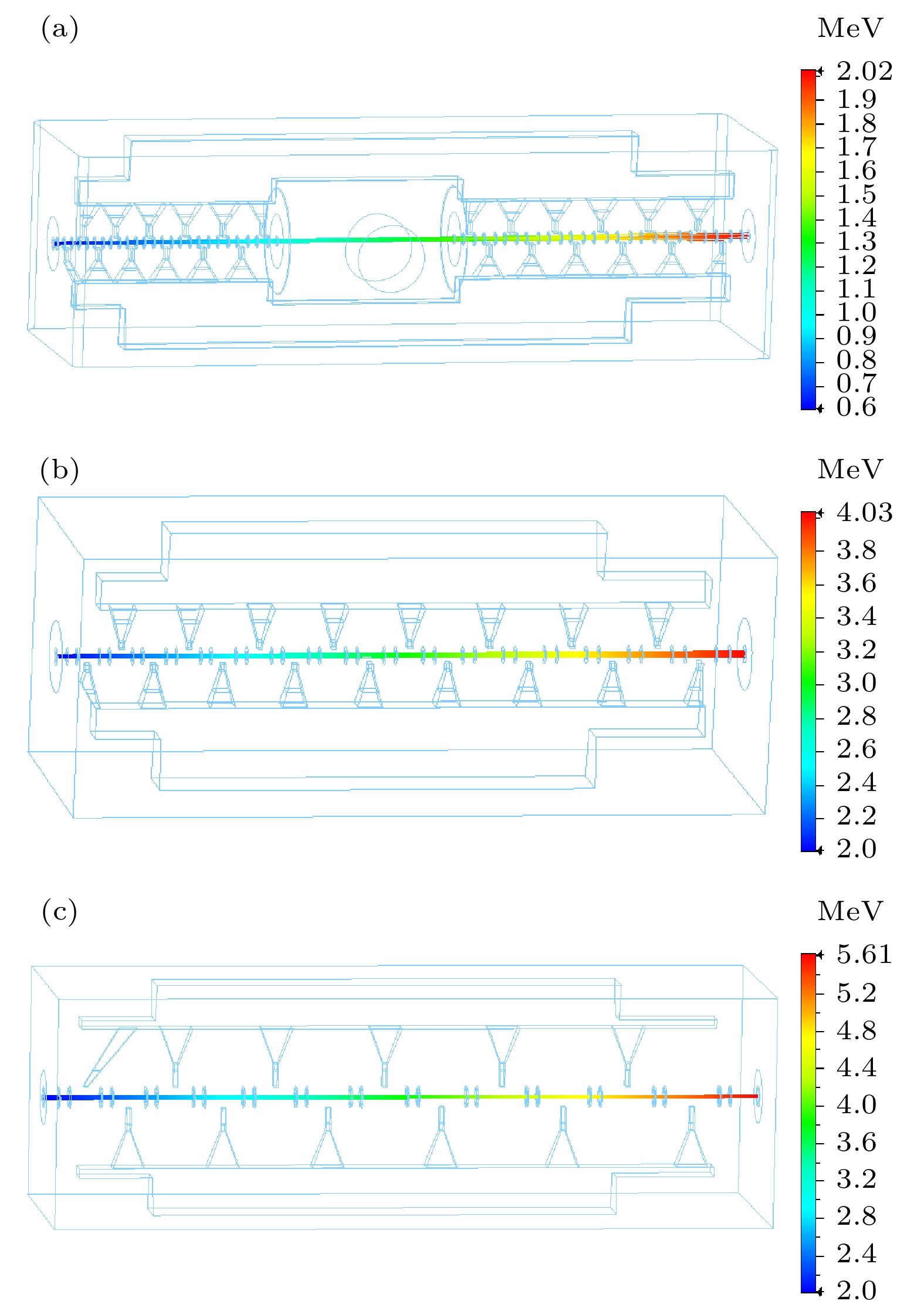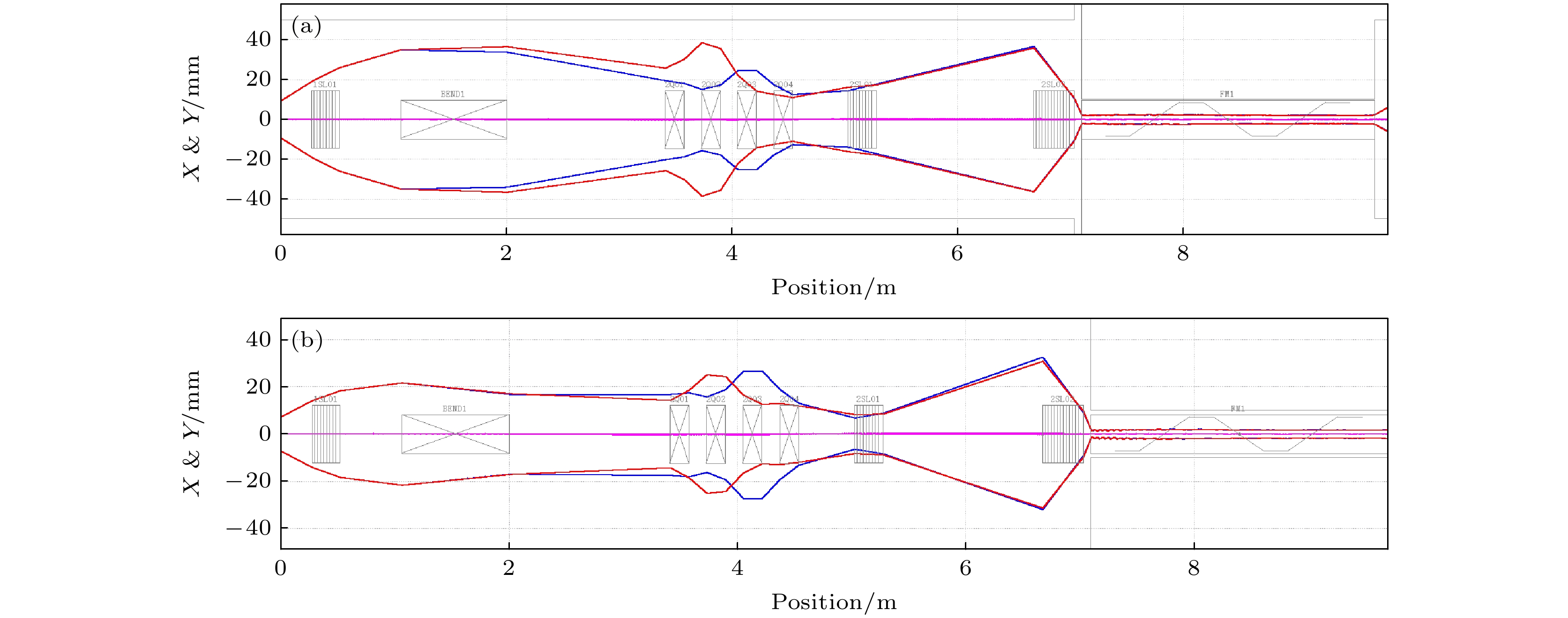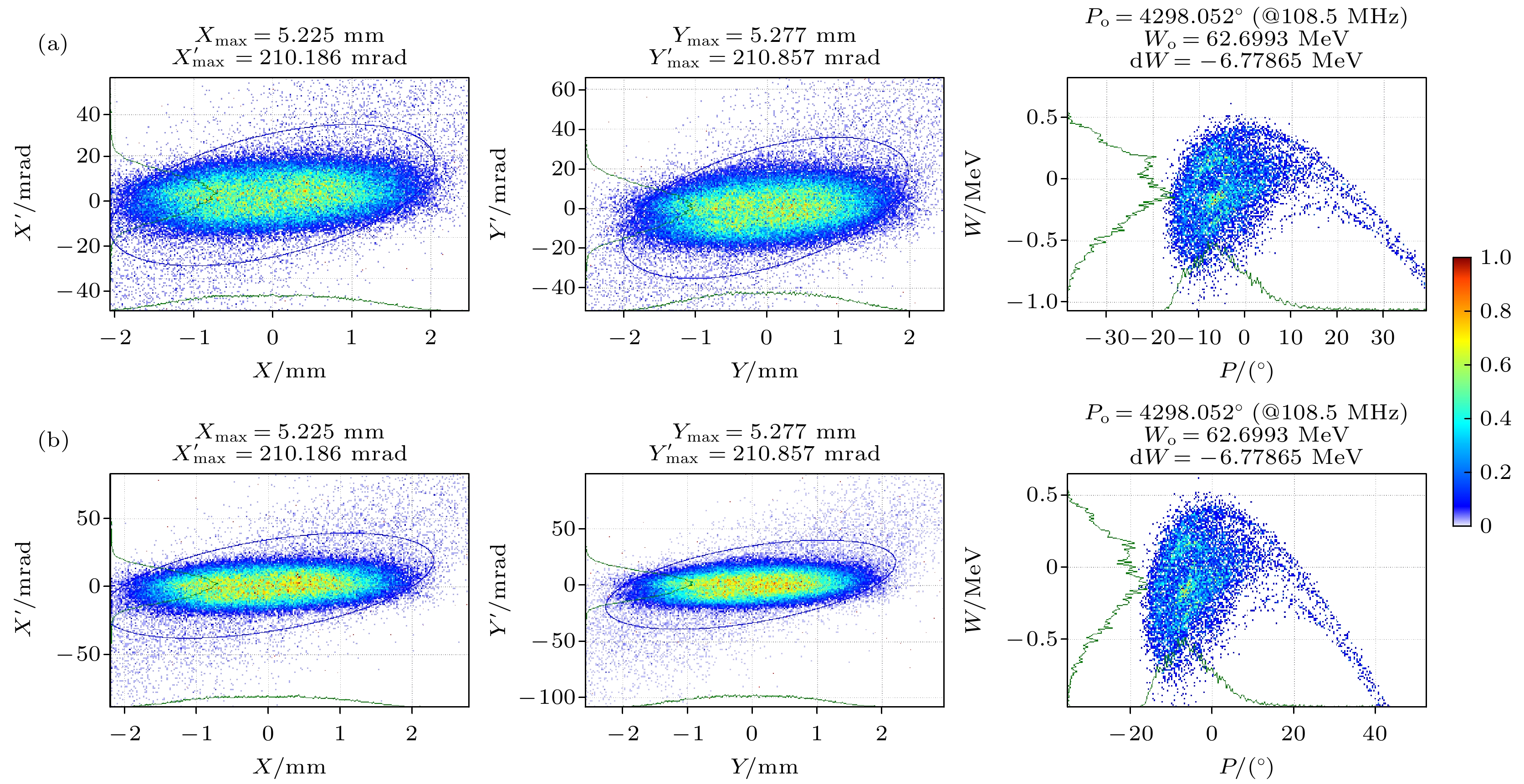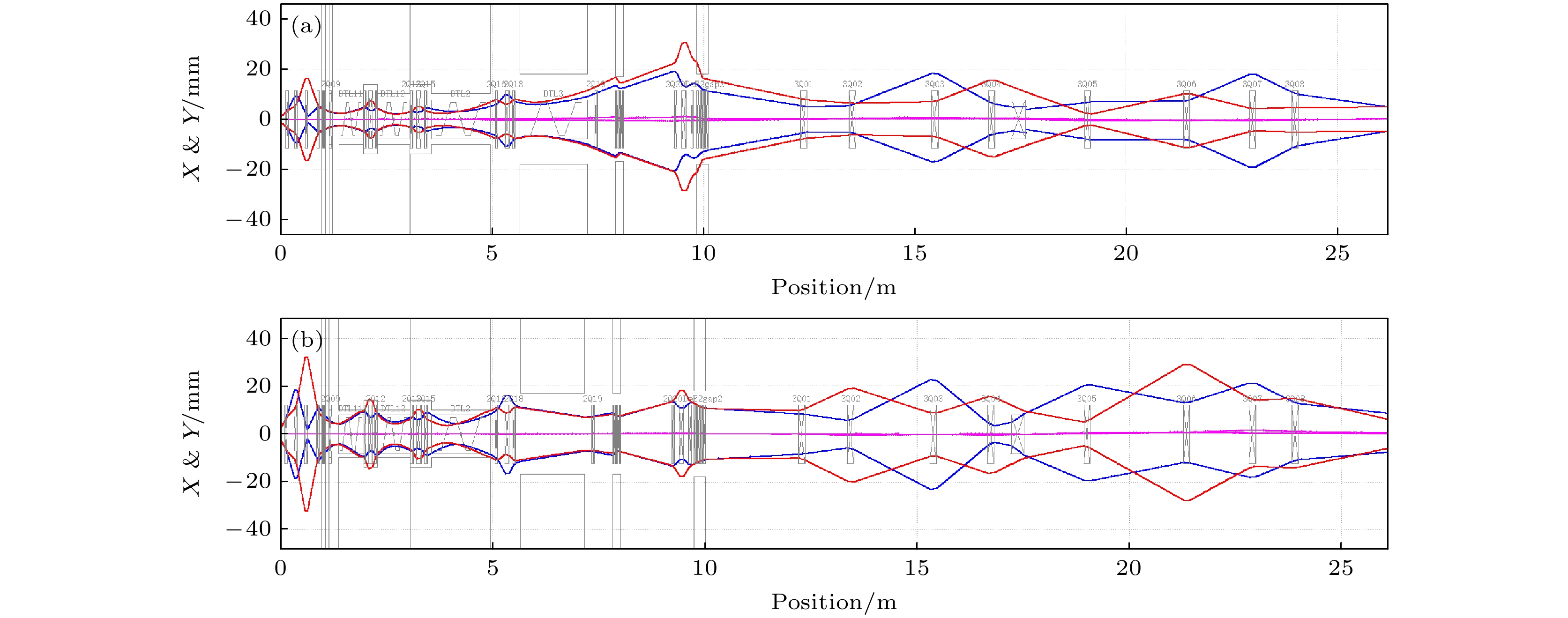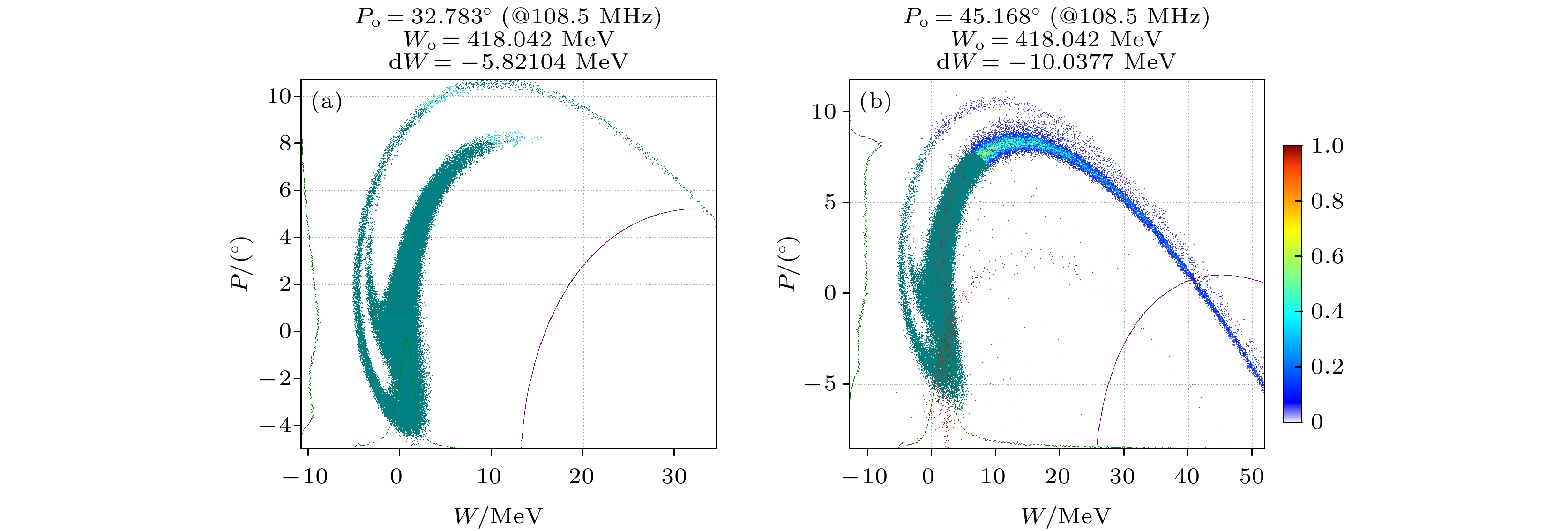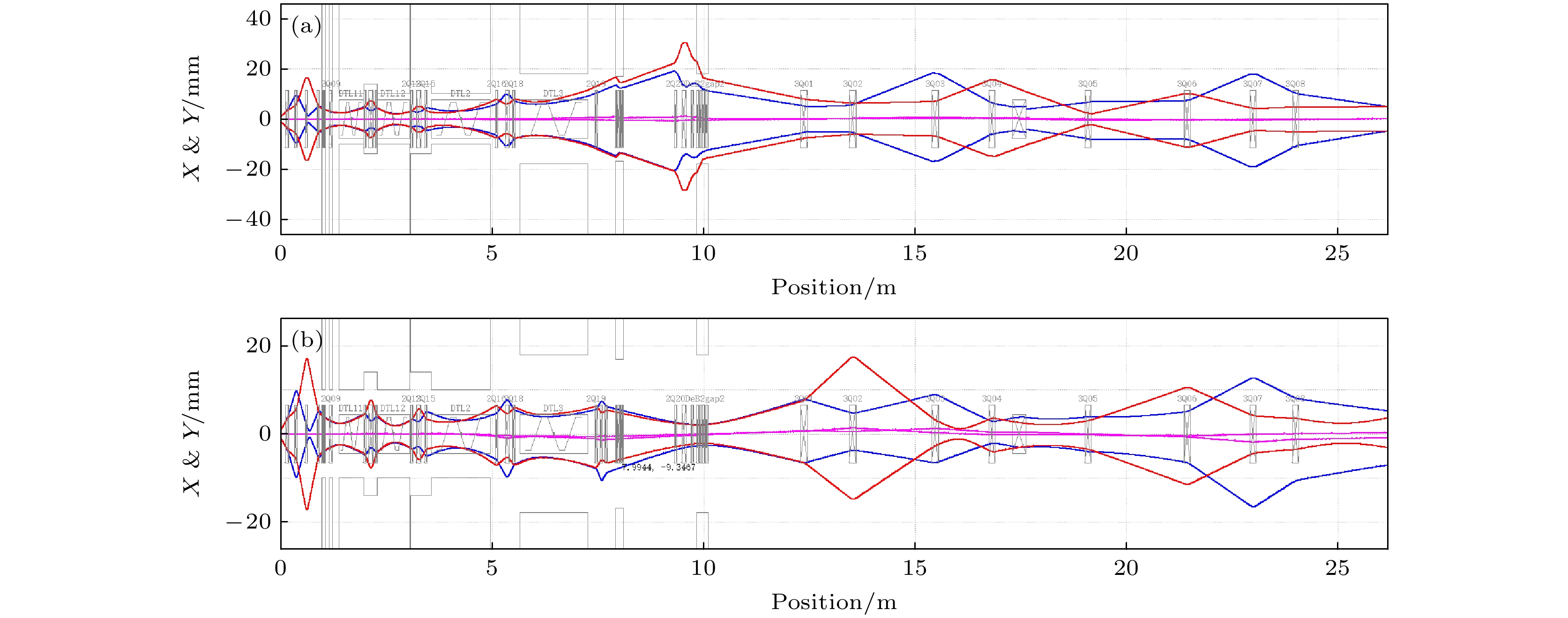-
为了完成SESRI 300 MeV同步加速器的束流调试, 使用Tracewin软件和加速腔电磁场分布文件建立了该加速器注入线从离子源出口到注入点的全尺寸模型, 在多粒子模式下计算了两种典型粒子束(质子、209Bi32+)在不同状态下的加速传输, 得到了注入线上束流相空间的变化过程和注入线的传输效率与接受效率. 研究结果表明, 300 MeV同步加速器注入线在加速不同荷质比的离子束流时, 电磁场参数设置基本与荷质比成反比. 束流的接受效率主要由射频四极加速腔出口发射度决定. 质子束和重离子束的接受效率差别较大. 在射频四极加速腔出口发射度为0.1π mm·mrad时, 209Bi32+束接收效率达到92.13%, 质子束的接收效率为68.18%. 分析束流传输过程表明, 当横向发射度过大时, 束流会因为纵向能散展宽和相位展宽而无法被最终接受. 在现有配置下, 质子束存在横向聚焦力不够、接受效率较低的问题. 通过额外增加2个四极铁能够将质子束的接受效率由68.18%提升至83.61%.SESRI 300 MeV synchrotron in Harbin Institute of Technology is now under construction and the whole equipment has been installed and tested. Before commissioning beam, the beam transport through the injection line is simulated by using a full-scall model through the Tracewin code. The field distribution of RFQ cavity is calculated with CST, and the results are substituted into the Tracewin code to generate the accurate results. The envelop mode and multi-particles mode are used in the beam simulation with two typical beams (H
${}_2^+ $ and 209Bi32+, the lightest beam and the heaviest beam). Both beams are accelerated from 4 keV/u to 2 MeV/u by an RFQ cavity and two IH-DTL cavities. Then the H${}_2^+ $ beam is stripped into a proton beam by a carbon foil and accelerated to 5.6 MeV with the third IH-DTL cavity. Simulation results show that the strength of the magnetic field and the acceleration field are proportional to the mass charge ratio. The beam transmission efficiency and the injection line reception are inversely proportional to the beam transverse emittance. The 209Bi32+ beam transmission efficiency and beam reception (momentum spread less than ±0.2%) are 72.16% and 46.72% with transverse emittance ε = 0.12π mm·mrad (ECR source output) and ε = 0.4π mm·mrad (RFQ output). H${}_2^+ $ beam transmission ratio and beam reception are 24.19% and 17.89% with ε = 0.2π mm·mrad (ECR source output) and ε = 0.5π mm·mrad (RFQ output). In order to obtain high transmission efficiency and beam reception, the transverse emittance should be limited to 0.1π mm·mrad after the RFQ. With this limitation, the 209Bi32+ beam transmission efficiency and the reception are increased to 96.68% and 92.63%, respectively, and the H${}_2^+ $ beam transmission efficiency and the rception rise to 74.40% and 68.18%, respectively. If two additional quadrupole magnets are added, the H${}_2^+ $ beam transmission efficiency and beam reception can be increased to 90.73% and 83.61%, respectively, which will fulfill the requirement for long-time operation. The phase space change process shows that loss of 209Bi32+ beam is caused mainly by longitudinal defocusing (energy spread and phase width spread), the loss of proton beam is caused both by the longitudinal defocusing and by the transverse defocusing (beam envelop spreading), that is why two additional focusing magnets should be added in proton beam acceleration. Results also show that by using field distribution calculation in the simulation process the greater influence of the cavity design details can be confirmed such as beam off-axis caused by dipole field in the IH-DTL cavity and beam loss caused by unperfect field in the RFQ. Tracking with field distribution is shown to be a useful method to link the cavity design process, beam line design process, and beam commission process.-
Keywords:
- synchrotron /
- injection line /
- transmission ratio /
- beam reception
[1] Qian C, Sun L T, Jia Z H 2020 Rev. Sci. Instrum 91 023313
 Google Scholar
Google Scholar
[2] 刘明 2017 硕士学位论文 (兰州: 近代物理研究所)
Liu M 2017 M. S. Dissertation (Lanzhou: Institute of Modern Physics) (in Chinese)
[3] 喻九维, 杨雅清, 吕明邦, 陈文军, 郑亚军, 许小伟, 陆海娇, 潘永祥 2021 强激光与粒子束 33 054001
Yu J W, Yang Y Q, Lü M B, Cheng W J, Zheng Y J, Xu X W, Lu H J, Pan Y X 2021 High Power Laser and Particle Beams 33 054001
[4] 李钟汕 2017 博士学位论文 (兰州: 近代物理研究所)
Li Z S 2017 Ph. D. Dissertation (Lanzhou: Institute of Modern Physics) (in Chinese)
[5] Ren H T, Pozdeyev E, Lund M S 2016 Rev. Sci. Instrum. 87 02B919
 Google Scholar
Google Scholar
[6] Akagi T, Bellan L 2020 Rev. Sci. Instrum. 91 023321
 Google Scholar
Google Scholar
[7] Clemente G, Ratzinger U, Podlech H, Groening L, Brodhage R, Barth W 2011 Phys. Rev. Spec. Top. Ac. 14 110101
[8] Yang Y, Dou W P, Sun L T 2016 Rev. Sci. Instrum. 87 02B910
 Google Scholar
Google Scholar
[9] Thuillier T, Angot J, Barue C 2016 Rev. Sci. Instrum. 87 02A733
 Google Scholar
Google Scholar
[10] Benedetti S, Bellodi G, Kuchler D 2018 Rev. Sci. Instrum. 89 123301
 Google Scholar
Google Scholar
[11] Ullmann C, Berezov R, Fils J 2014 Rev. Sci. Instrum. 85 02A952
 Google Scholar
Google Scholar
[12] 颜学庆, 陆元荣, 吴瑜, 张宏林, 高淑丽, 方家训 2002 北京大学学报 (自然科学版) 38 1
Yan X Q, Lu Y R, Wu Y, Zhang H L, Gao S L, Fang J X 2002 Universitatis Pekinensis 38 1
[13] 吴瑜 1999 北京大学学报 (自然科学版) 35 3
Wu Y 1999 Universitatis Pekinensis 35 3
[14] 王科栋 2019 博士学位论文 (兰州: 近代物理研究所)
Wang K D 2017 Ph. D. Dissertation (Lanzhou: Institute of Modern Physics) (in Chinese)
[15] Winklehner D, Hammond R, Alons J 2016 Rev. Sci. Instrum. 87 02B929
 Google Scholar
Google Scholar
[16] Otani M, Mibe T, Yoshida M 2016 Phys. Rev. Accel. Beams 19 040101
 Google Scholar
Google Scholar
[17] He T, Lu L, He Y, Hang Y L, Ma W, Tan T, Zhang Z L, Yang L, Xing C C, Li C X, Sun L P 2021 Nuclear Inst. Meth. Phys. Research A 1010 165466
 Google Scholar
Google Scholar
[18] Wang K D, Yuan Y J, Yin X J, Yang J C, Li Z S, Du H, Li X N, Kong Q Y, Wang K, Dong Z Q, Liu J, Xia J W 2019 Nuclear Inst. Meth. Phys. Research A 927 375
 Google Scholar
Google Scholar
[19] Uriot D 2003 Proceedings of the 2003 Particle Accelerator Conference, Portland, USA, May 12–16, 2003 p3491
[20] 吕建钦 2003 带电粒子束光学 (北京: 高等教育出版社) 第267页
Lv J Q 2003 The Optics of Charged Particle Beams (Beijing: Higher Education Press) p267 (in Chinese)
[21] 陈佳洱 2019 加速器物理基础 (北京: 北京大学出版社) 第353页
Chen J Er 2019 Foundment Physics of Accelerator (Beijing: Peking University Press) p353 (in Chinese)
-
表 1 注入线粒子束的指标
Table 1. Beam parameters of the injection line.
指标 要求 粒子种类 A/Q < 6.53的任意粒子 能量 重离子束2 MeV/u; 质子束5.6 MeV 流强 重离子束50e μA; 质子束250 μA 90%自然发射度 < 15π mm·mrad Δp/p < ± 0.2% 表 2 RFQ输出束团横向发射度对注入线传输效率和接受效率的影响
Table 2. Transmission ratio and beam acceptance of the injection line with different transverse emittance output by RFQ.
横向发射度
/(mm·mrad)质子束 209Bi32+束 传输
效率/%接受
效率/%传输
效率/%接受
效率/%0.5π 24.19 17.84 57.48 35.29 0.4π 31.26 24.37 72.16 46.72 0.3π 42.25 32.31 85.98 56.94 0.2π 56.80 47.56 95.86 74.00 0.1π 74.40 68.18 96.68 92.63 表 3 注入线束流发射度、环的接受度及twiss参数对比
Table 3. List of the injection beam emittance, ring acceptance and twiss parameters.
注入束流参数 环的接受参数 εx/(mm·mrad) 13.1π 200π εy/ (mm·mrad) 9.7π 30π βx/m 1.63 4.963 βy/m 1.69 2.105 αx 0.6143 1.0263 αy –0.6558 –1.1720 Δp/p/% ± 0.2 ± 0.3 D 0.15 1.6582 D' –0.20 0.9391 -
[1] Qian C, Sun L T, Jia Z H 2020 Rev. Sci. Instrum 91 023313
 Google Scholar
Google Scholar
[2] 刘明 2017 硕士学位论文 (兰州: 近代物理研究所)
Liu M 2017 M. S. Dissertation (Lanzhou: Institute of Modern Physics) (in Chinese)
[3] 喻九维, 杨雅清, 吕明邦, 陈文军, 郑亚军, 许小伟, 陆海娇, 潘永祥 2021 强激光与粒子束 33 054001
Yu J W, Yang Y Q, Lü M B, Cheng W J, Zheng Y J, Xu X W, Lu H J, Pan Y X 2021 High Power Laser and Particle Beams 33 054001
[4] 李钟汕 2017 博士学位论文 (兰州: 近代物理研究所)
Li Z S 2017 Ph. D. Dissertation (Lanzhou: Institute of Modern Physics) (in Chinese)
[5] Ren H T, Pozdeyev E, Lund M S 2016 Rev. Sci. Instrum. 87 02B919
 Google Scholar
Google Scholar
[6] Akagi T, Bellan L 2020 Rev. Sci. Instrum. 91 023321
 Google Scholar
Google Scholar
[7] Clemente G, Ratzinger U, Podlech H, Groening L, Brodhage R, Barth W 2011 Phys. Rev. Spec. Top. Ac. 14 110101
[8] Yang Y, Dou W P, Sun L T 2016 Rev. Sci. Instrum. 87 02B910
 Google Scholar
Google Scholar
[9] Thuillier T, Angot J, Barue C 2016 Rev. Sci. Instrum. 87 02A733
 Google Scholar
Google Scholar
[10] Benedetti S, Bellodi G, Kuchler D 2018 Rev. Sci. Instrum. 89 123301
 Google Scholar
Google Scholar
[11] Ullmann C, Berezov R, Fils J 2014 Rev. Sci. Instrum. 85 02A952
 Google Scholar
Google Scholar
[12] 颜学庆, 陆元荣, 吴瑜, 张宏林, 高淑丽, 方家训 2002 北京大学学报 (自然科学版) 38 1
Yan X Q, Lu Y R, Wu Y, Zhang H L, Gao S L, Fang J X 2002 Universitatis Pekinensis 38 1
[13] 吴瑜 1999 北京大学学报 (自然科学版) 35 3
Wu Y 1999 Universitatis Pekinensis 35 3
[14] 王科栋 2019 博士学位论文 (兰州: 近代物理研究所)
Wang K D 2017 Ph. D. Dissertation (Lanzhou: Institute of Modern Physics) (in Chinese)
[15] Winklehner D, Hammond R, Alons J 2016 Rev. Sci. Instrum. 87 02B929
 Google Scholar
Google Scholar
[16] Otani M, Mibe T, Yoshida M 2016 Phys. Rev. Accel. Beams 19 040101
 Google Scholar
Google Scholar
[17] He T, Lu L, He Y, Hang Y L, Ma W, Tan T, Zhang Z L, Yang L, Xing C C, Li C X, Sun L P 2021 Nuclear Inst. Meth. Phys. Research A 1010 165466
 Google Scholar
Google Scholar
[18] Wang K D, Yuan Y J, Yin X J, Yang J C, Li Z S, Du H, Li X N, Kong Q Y, Wang K, Dong Z Q, Liu J, Xia J W 2019 Nuclear Inst. Meth. Phys. Research A 927 375
 Google Scholar
Google Scholar
[19] Uriot D 2003 Proceedings of the 2003 Particle Accelerator Conference, Portland, USA, May 12–16, 2003 p3491
[20] 吕建钦 2003 带电粒子束光学 (北京: 高等教育出版社) 第267页
Lv J Q 2003 The Optics of Charged Particle Beams (Beijing: Higher Education Press) p267 (in Chinese)
[21] 陈佳洱 2019 加速器物理基础 (北京: 北京大学出版社) 第353页
Chen J Er 2019 Foundment Physics of Accelerator (Beijing: Peking University Press) p353 (in Chinese)
计量
- 文章访问数: 6804
- PDF下载量: 114
- 被引次数: 0















 下载:
下载:
